Climate Change is wreaking havoc on the existing Civil Infrastructure all over the world, including India. With a view to create awareness about this amongst the young students from engineering colleges, LCCF, in association with the of the Indian Concrete Institute (ICI) conducted an essay competition amongst the members of the Student Chapters of ICI. The essay competition was held on the theme ‘Climate Resilience Infrastructure’. Six topics were given under the theme which included (i) Challenges in the Planning and Design of Climate Resilient Bridges and Road infrastructure, (ii) Mitigation strategies for safeguarding existing Infrastructure in cyclone-prone areas, (iii) Urban Flooding: Future Challenges and Solutions, (iv) Strategies for integrating Climate Resilience in protecting Urban Infrastructure, (v) Smart Cities and Climate-Resilient Infrastructure: Technologies and Applications, and (vi) Climate Resilience in Rural Infrastructure Development. A number of entries were received from student community. After initial scrutiny of the essays by the LCCF office, selected essays were sent for the evaluation by Referees, who selected the one essay for the award. While LCCF would like to thank the participants for sending their essays, we are pleased to include the award-winning essay from Mr Jai Siddarth A in the current newsletter.
Urban Flooding: Challenges and Solution
INTRODUCTION
Urban flooding remains the most frequent man-made disaster affecting huge population worldwide every year owing to many reasons such as climate change causing unpredictable and irregular rains, decreased permeable ground layer for percolation of rain water due to the construction of increased housing and infrastructure.
Since 2008, extreme weather events such as storms and floods have displaced over 20 million people annually, according to the Intergovernmental Panel on Climate Change [1]. Recent estimates indicate that approximately 1.81 billion individuals—nearly 23% of the global population—reside in regions vulnerable to 1-in-100-year flood events, with 89% of them living in low- and middle-income countries [2]. Urban flooding has emerged as a growing concern across the globe, especially in areas with dense populations and significant infrastructure. It refers to the inundation of built environments resulting from rainfall overwhelming drainage systems, particularly in places with large expanses of impervious surfaces. The Federal Emergency Management Agency [3] defines urban flooding as "the inundation of property in a built environment, particularly in more densely populated areas, caused by rain falling on increased amounts of impervious surfaces and overwhelming the capacity of drainage systems." While often associated with expanding megacities, urban flooding also poses a significant risk in small and medium-sized cities, where resources to prevent and manage such events are often limited.
Civil engineering is meant to be the art and science of growth of humans partnering with nature, thus maintaining sustainability of built environment. Eventually in a haste of rapid urbanization and industrial needs, the consideration for preservation of natural eco system in the forms of lakes, rivers, trees providing green cover is lost or not given due attention This gap or missing factor while designing city and infrastructure leads to disaster like flooding disrupting normalcy of human life. The rapid increase in infrastructure - buildings, roads, bridges or industrial structure - leads to coverage of ground with increased impermeable layers
UNDERSTANDING URBAN FLOODING
India faces significant flood challenges, with an average annual loss from floods estimated to be approximately ₹616.52 billion (using an approximate conversion of 1 USD = ₹83.31) and 12% of its land area vulnerable. In cities like Chennai (its population nearly doubled to 8 million by 2021), rapid urbanization has severely degraded natural water bodies and increased flood vulnerability.
Despite efforts of improved drainage under the Flood Management Programmes, and NITI Aayog's emphasis on structural and non-structural measures (e.g., discouraging flood-prone development, early warnings, water-sensitive planning), the problem of urban flooding persists. Destructive events in cities like Hyderabad (2000), Ahmedabad (2001), Delhi (2002, 2003, 2009), Chennai (2004, 2015), Mumbai (2005, 2017), and Kolkata (2007) highlight the urgent need for improved, trans-disciplinary flood management and risk-informed decisions.
FACTORS RESPONSIBLE FOR URBAN FLOODS
The main factors responsible for urban flooding are summarized in Table 1.
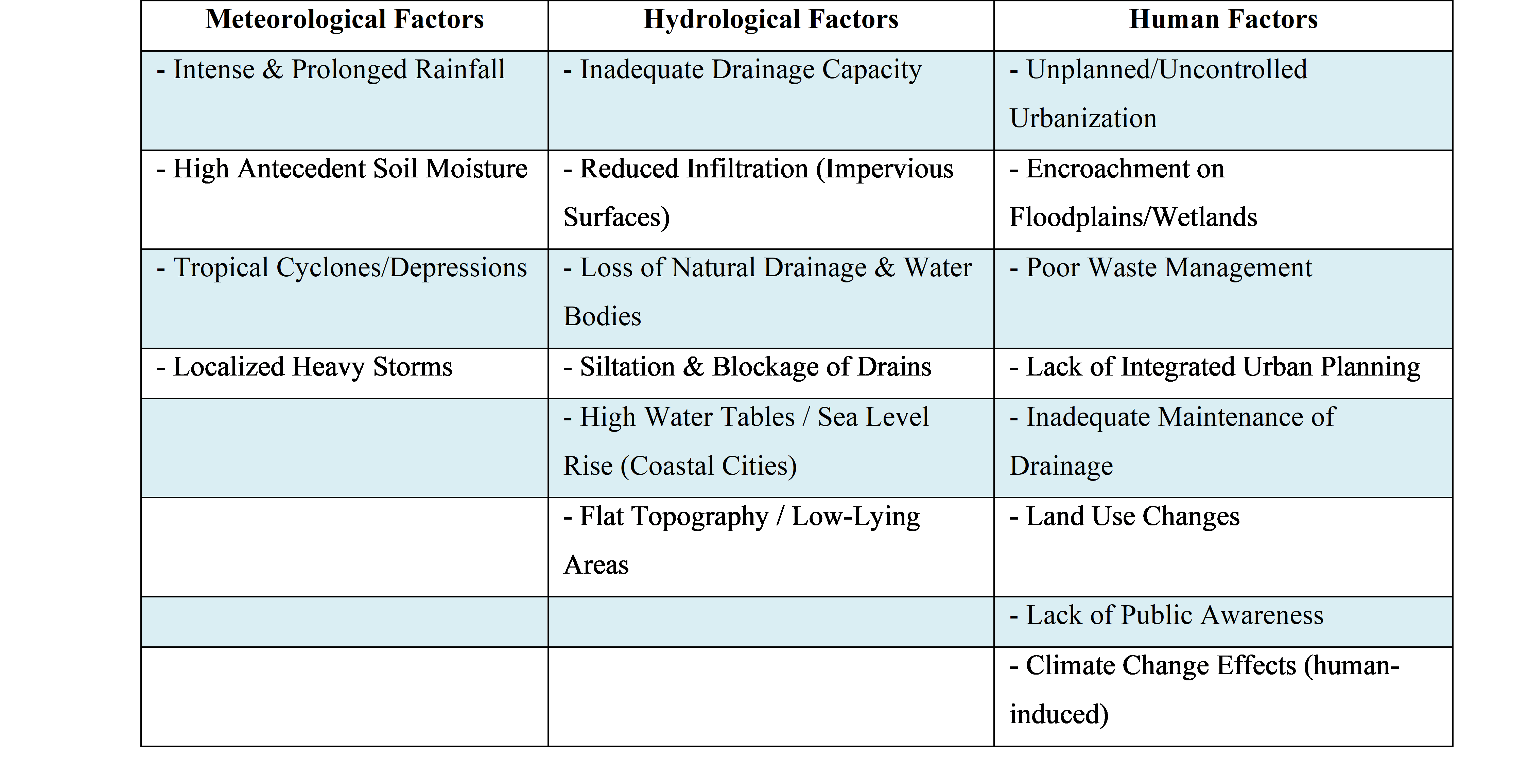
Table 1 Factors responsible for urban flooding
CHALLENGES OF URBAN FLOODING
The challenges faced in urban flooding from environmental and civil engineering perspectives are listed below.
1. Challenges from Environmental Perspective
- Climate Change: More frequent extreme weather events.
- Loss of Natural Buffers: Wetlands and green cover reduced due to urban sprawl.
- Water Quality Issues: Runoff carries pollutants into natural waterways.
- Biodiversity Impact: Floods destroy urban ecosystems.
2. Challenges from Civil Engineering Perspective
- Aging Infrastructure: Old drainage systems not designed for current loads.
- Poor Urban Planning: Rapid development outpacing infrastructure upgrades.
- Lack of Real-Time Data: Limited monitoring of water levels and flows.
- Maintenance Deficiencies: Blocked or poorly maintained drains.
- High population density
- Inadequate drainage system
3. Climate Change
The increasing frequency of extreme weather events, such as storms and cyclones, exacerbates the risk of flooding. Rising sea levels compound the challenge, making it more difficult to manage water flow within cities located in the coastal belt.
The Chennai floods underlined the failure of drainage systems, unchecked urbanization, and encroachment on water bodies. Over 500,000 people were displaced, with losses exceeding ₹15,000 crores. This is a stark warning for cities across India, Fig 2[6]
4. Loss of Natural Buffer
Encroachment into water bodies and wetlands, which previously acted as buffers to absorb excess rainwater, has significantly reduced. When these ecosystems are disrupted, the prospect of flooding increases dramatically.
Take for example the case of the East Kolkata Wetlands, a Ramsar site recognized by UNESCO, Fig 3. It has been a natural buffer against urban flooding for centuries. However, the capacity of these wetlands has drastically been reduced by urbanization. Restoration efforts bring out the critical role of wetlands in flood prevention.
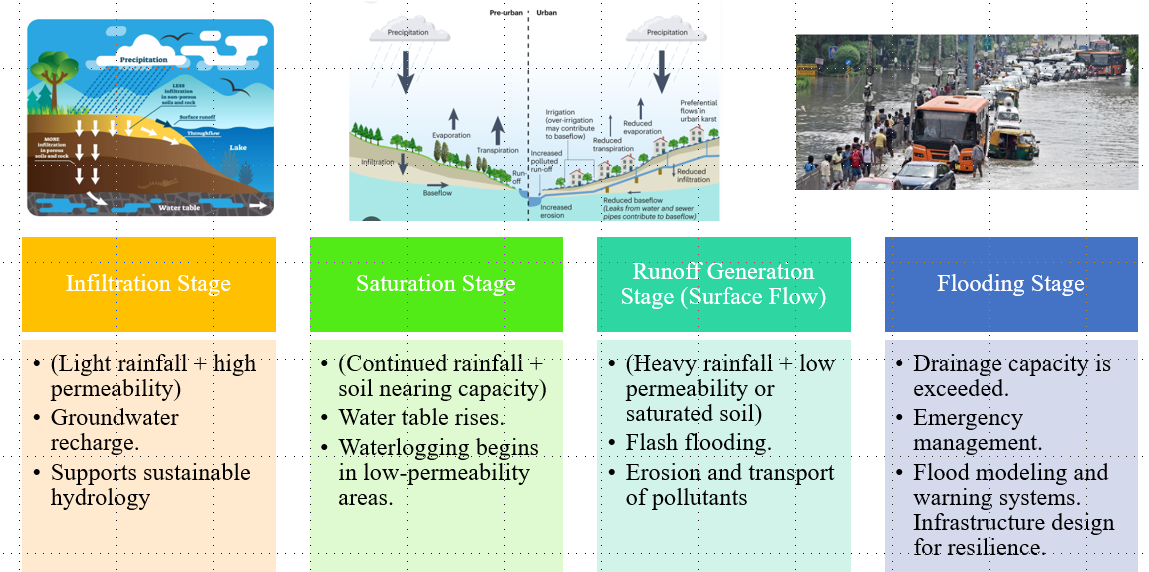

5. High Population Density
Overcrowding in cities like Chennai is driven by rapid urbanization. As more people are accommodated through housing and infrastructure development, rivers, lakes, and wetlands are paved over or occupied. During heavy rains, there is increased runoff because there is nowhere for the water to be absorbed naturally.
For instance, the flood that occurred in Mumbai, India, in 2005 presents a grim example. It rained an average of over 900 millimeters within 24 hours that resulted in the death of over 1,000 people and caused infrastructural damage. High population density was one of the factors that heightened flooding as natural water courses were replaced by concrete structures, limiting the absorption of waters. [6]
6. Inadequate Drainage Systems
Many cities, especially in developing nations, have outdated or underdeveloped drainage systems. These systems are often ill-equipped to handle heavy rainfall, leading to significant flooding even during moderate storms, primarily due to poor maintenance and planning.
In Chennai, the floods in 2015 showcased the city's drainage deficiencies. The inadequate system was overwhelmed, resulting in over 500,000 people being displaced and extensive damage to property and infrastructure. The city's failure to upgrade its drainage systems despite rapid urbanization contributed to this crisis. [6]
STATERGIES FOR URBAN FLOOD MITIGATIONS
Some measures required for mitigating urban flooding are listed below.
1. Creating Sponge Cities
This concept involves designing urban areas to absorb, store, infiltrate, and purify rainwater at its source, mimicking natural hydrological cycles. It uses permeable surfaces, green infrastructure, and decentralized water management to manage excess runoff locally, reducing pressure on conventional drainage systems and recharging groundwater.
2. Improved Drainage System
This entails upgrading and expanding existing stormwater drainage networks, including pipes, culverts, and open channels, to adequately handle increased rainfall volumes. It also involves regular maintenance like desilting and clearing blockages to ensure the full design capacity of the drains is utilized, allowing for efficient water evacuation from urban areas.
3. Rainwater Harvesting by Residential Societies
This measure encourages residential communities to collect and store rainwater from rooftops and other impervious surfaces. The harvested water can be used for non-potable purposes (e.g., gardening, toilet flushing) or directed to recharge groundwater aquifers, thereby reducing the volume of stormwater runoff entering the drainage system and alleviating flood pressure.
4. Rejuvenate Water Bodies
This involves restoring and rehabilitating natural water bodies like lakes, ponds, wetlands, and traditional tanks that have been encroached upon or degraded. Revitalizing these natural buffers increases their capacity to temporarily store excess rainwater, facilitate natural infiltration, and regulate floodwaters, enhancing the urban landscape's resilience.
5. Mangrove Network to Absorb Impact of Coastal Water Rise
For coastal cities like Mumbai, Kolkata, Chennai, establishing and preserving healthy mangrove ecosystems along the coastline acts as a natural green barrier. Mangroves dissipate wave energy, stabilize shorelines, and reduce the impact of storm surges and coastal high tides, preventing saltwater intrusion and minimizing inundation in low-lying coastal areas during extreme weather events.
6. Sponge Park / Pocket Forest
These are strategically designed green spaces within urban areas that incorporate features like permeable pathways, rain gardens, bioswales, and native vegetation. They are engineered to absorb, filter, and slowly release stormwater runoff, acting as decentralized mini-reservoirs. These spaces not only reduce flood risk but also enhance urban biodiversity and air quality.
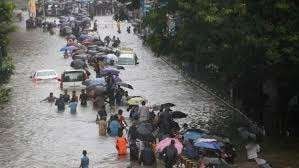

Fig.4(a) (b): The flood that occurred in Mumbai, India, in 2005
Sources: Times of India, The Indian Express
CASE STUDIES IN INDIA
1. Davangere, a city in Karnataka
This city frequently experienced urban flooding during the rainy season. To address this, the city undertook a comprehensive survey of its drainage network, accurately identifying areas most in need of storm water infrastructure. A targeted approach was then implemented, beginning within the Smart City area with the construction of 69 km of new storm water drains, Fig 5. Four years following these interventions, Davangere witnessed a dramatic transformation: waterlogging ceased, flooding was eliminated, and school closures due to inundation became a thing of the past. This remarkable improvement was significantly bolstered by citizen awareness and effective waste management. Regular awareness campaigns educated residents on maintaining clear drains, directly contributing to the city's flood prevention efforts. Ultimately, these measures reduced urban floods by a remarkable 90%, allowing heavy rains to drain quickly and efficiently.
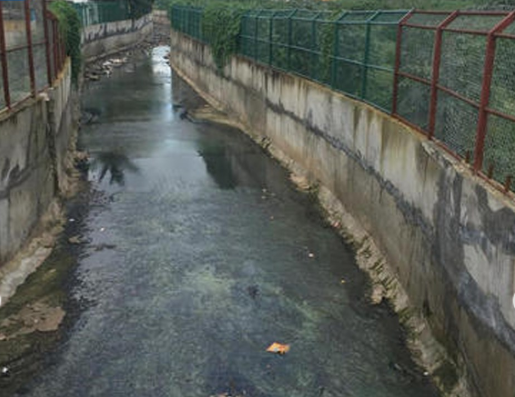
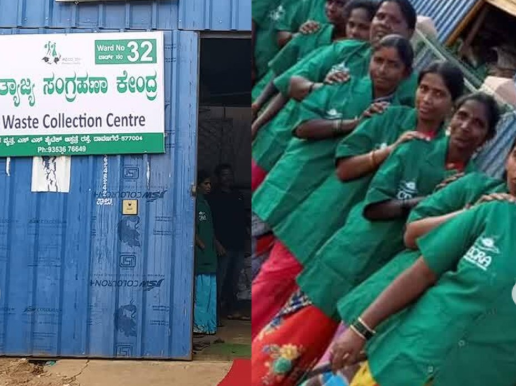
Fig.5 (a) (b): Drainage system and Solid waste management in Davanagere
Sources: Better India, Media company
2. Tamil Nadu: Mangrove forest
Tamil Nadu is transforming barren, salty land near Chennai's Buckingham Canal into a thriving mangrove forest using a "fishbone technique", Fig 6. This smart design diverts water from creeks through feeder and field channels, shaped like fishbones, ensuring water reaches all corners of the land, transforming the barren, salty soil into fertile ground where mangroves can thrive. Now, seven 'fishbone' trenches, 87 channels, and 80 canals form a protective mangrove fortress shielding the coastlines. These mangroves are crucial "climate super fighters," absorbing carbon, calming storm surges, and nurturing marine life.
Regarding urban flood mitigation, this mangrove network directly render help by:
- Calming storm surges: Mangroves act as a natural barrier, dissipating the energy of incoming storm surges and high tides, which significantly reduces the inland penetration of floodwaters.
- Stabilizing coastlines: Their dense root systems help to hold soil in place, preventing erosion and reducing sediment accumulation in channels, which can otherwise impede water flow and exacerbate flooding.
- Water Quality Issues: Runoff carries pollutants into natural waterways.
- Providing a living buffer: This green fortress offers a natural defense against coastal water rise, protecting the city's infrastructure and population from the direct impact of coastal flooding.
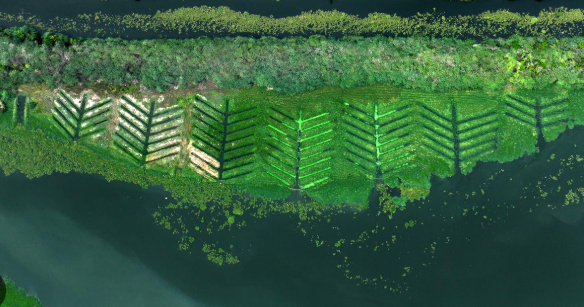 Fig.6: fishbone technique — Mangrove forest
Fig.6: fishbone technique — Mangrove forest
Sources: Better India & The Hindu , Media company
3. Sponge city: Chennai
Chennai city frequently battles severe floods. Stranded citizens are now fighting back with an innovative approach: sponge parks. These green spaces are specifically designed to absorb excess rainwater and prevent inundation. In early 2023, Chennai successfully implemented 57 such sponge parks in its most flood-prone areas, Fig 7. These parks proved crucial in significantly reducing flooding and managing rainwater during the aftermath of Cyclone Michaung.
Building on this success, 50 more sponge parks are currently under development in North Chennai, a project estimated to cost ₹88 crore and expected to harvest 75 million liters of rainwater. Sponge parks are characterized by open green areas featuring pod-like depressions, approximately five feet deep, carved out of previously unused land. Drains from nearby streets are ingeniously connected to these depressions, allowing rainwater to collect naturally.
Beyond these innovative parks, the Greater Chennai Corporation is undertaking extensive efforts to further flood-proof the city, including restoring 194 water bodies, regularly desilting drains, strengthening bunds, and constructing eco-parks near culverts. Chennai's resilience is also being enhanced through rapid greening initiatives, with the establishment of 37 Miyawaki pocket forests and 871 urban parks. These dense forests actively absorb rainwater, slow down runoff, and contribute to reducing urban heat, adding another vital layer of defense against flooding.
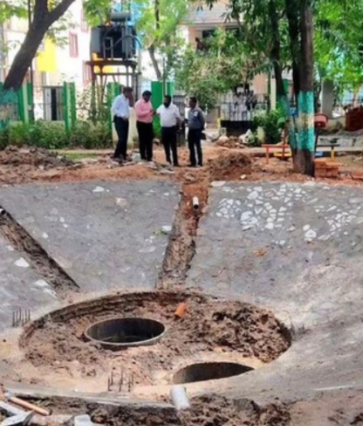
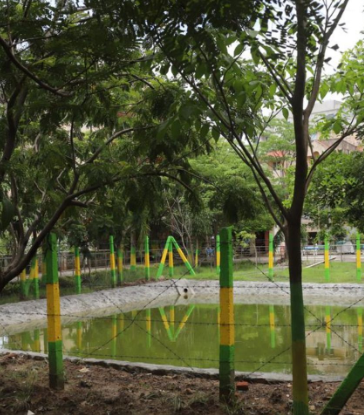
Fig.7(a) (b): Sponge park in Chennai
Sources: Better India & The Hindu , Media company
4. Agartala
Historically the capital of Tripura, used to experience massive urban flooding during its six-month heavy rainfall season, even with a single day's precipitation of 20mm. To effectively tackle this challenge, the city initiated a comprehensive mapping of its 340-km drainage system in 2018, Fig 8. This foundational step led to the demolition of encroachments, even in posh areas, to clear natural water flow paths. After precisely gauging where stormwater drains were most needed, Smart City funds were strategically utilized to construct 25km of new concrete drains.
Beyond infrastructure development, Agartala implemented a multi-pronged monitoring and response system. Surveillance cameras were installed to continuously monitor inundation in low-lying areas. Sluice gates and mechanical drain cleaning equipment were also deployed to manage water flow and prevent blockages. A comprehensive monitoring system was established to oversee the city’s flood situation around the clock, with constant vigilance over stormwater discharge points.
Furthermore, diesel-powered pumps were set up to manage localized flash floods efficiently. These concerted efforts have drastically reduced water accumulation time, from an alarming two to three days to less than an hour, even during heavy rainfall events.
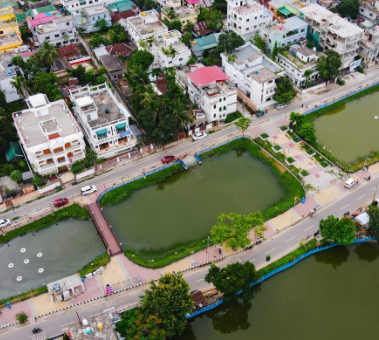
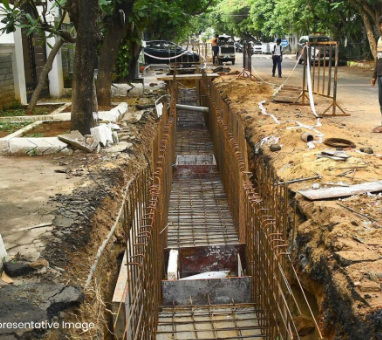
Fig.8 (a) (b): Storm water drain in Agartala
Sources: Better India & The Hindu, Media company
SOLUTIONS TO MITIGATE URBAN FLOODING
Mitigation of urban flooding requires innovative solutions that address both immediate challenges and long- term problems. The following strategies are commonly employed:
1. Decentralization: The Sustainable Agenda
Decentralization provides a long-term solution by dispersing population and infrastructure across multiple urban centres. Rather than concentrating development in one city, decentralization advocates creation of smaller, better-planned urban hubs around major cities, for example metropolitan cities like Mumbai, Kolkata, Chennai, Delhi, etc. By reducing pressure on infrastructure and protecting natural ecosystems, the risk of flooding can be minimized.
These smaller urban centres can preserve natural landscapes such as wetlands and lakes, allowing floodwater to be absorbed and reducing runoff. Decentralized cities can also incorporate flood-resistant infrastructure from the outset, making them less vulnerable to extreme climatic events.
South Korea has decentralized towards reducing the population in the capital Seoul, by encouraging secondary cities like Sejong. This will distribute population density and reduce infrastructure strain, hence reinforcing the resilience of these cities against floods. [8]. While smaller urban centres can support wetlands and lakes; they can absorb floodwater while controlling runoff.
2. Green Infrastructure and Nature-Based Solutions permeation
Another vital intervention lies in the integration of green infrastructure to improve urban water management. This includes the construction of permeable pavements, rain gardens, and green roofs, which allow for better water permeation. Such interventions reduce runoff during storms, helping cities to act as natural sponges that absorb excess rainwater.
The 2005 Mumbai floods were a wake-up call for urban flood management in India. After the disaster, rainwater harvesting became mandatory in new developments, reducing stormwater runoff and enhancing the city's resilience during monsoons. This policy is a scalable model for flood-prone cities across the country [6]. One example is shown in Fig 9.

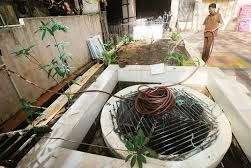
Fig.9 (a) (b): Rainwater Harvesting in local buildings, Mumbai
Sources: DNAindia.com
3. Upgrading Storm Water Drainage Infrastructure
Besides decentralization and green infrastructure, cities must invest in upgrading their drainage systems. Many urban centres still rely on obsolete systems that fail to handle sudden downpours caused by storms. Improved flood resilience can be achieved by retrofitting stormwater drainage networks to accommodate heavier rainfall, constructing flood channels, or building storm water detention basins.
Tokyo, Japan, has invested heavily in upgrading its drainage systems, Fig 10. The city’s advanced underground drainage network, known as the Metropolitan Area Outer Underground Discharge Channel, was completed in 2006 and has significantly mitigated flooding risks, demonstrating the effectiveness of modern infrastructure in flood management [3]
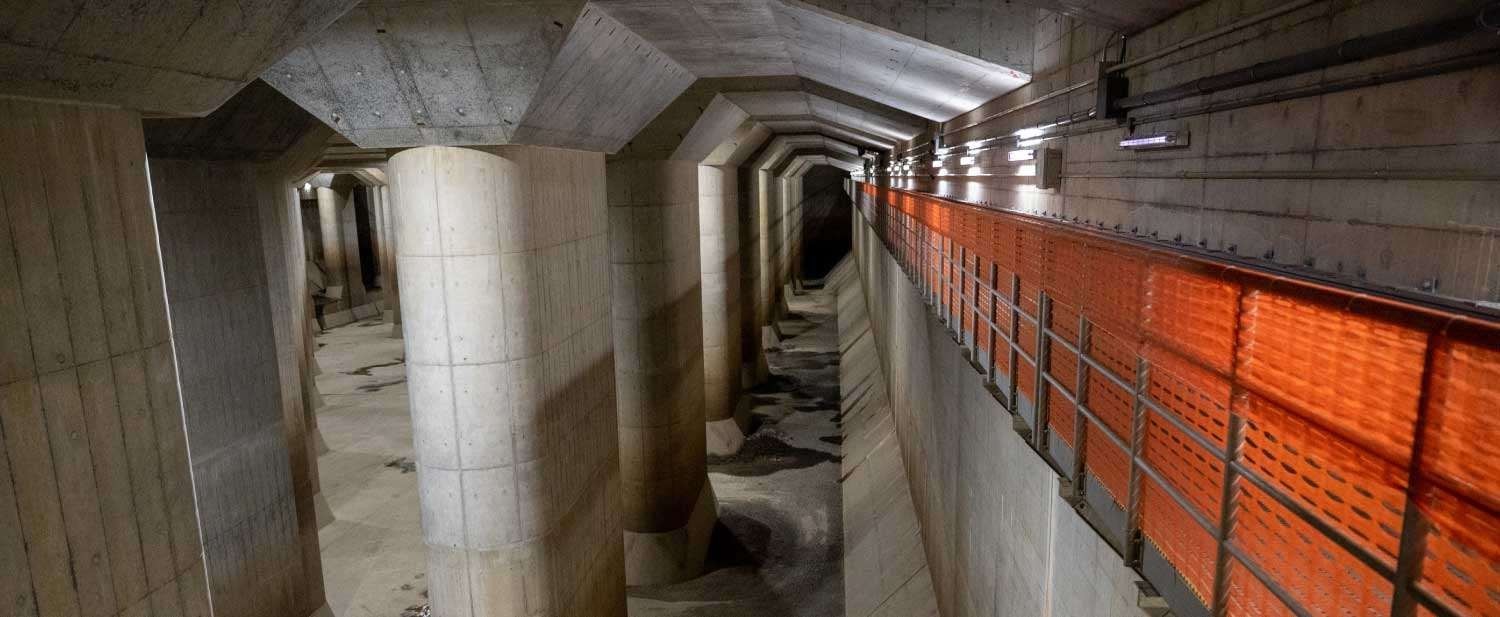 Fig.10: Tokyo city’s advanced underground drainage network
Fig.10: Tokyo city’s advanced underground drainage network
Sources: Wikipedia
4. Community Engagement and Preparedness
Public education and involvement in flood preparedness and response strategies are essential. Public awareness campaigns on flood risks, emergency evacuation routes, and water conservation practices can empower communities to act quickly during floods. Additionally, involving local communities in vulnerability assessments helps cities better understand the needs of their residents, allowing for more targeted and effective solutions.
During the Kerala floods of 2018, community participation proved to be very crucial in minimizing the disaster impact. Citizens coordinated rescue operations with local governments, distributed essential supplies, and assisted. After the disaster, the government focused on flood mapping, mitigation strategies, and community awareness programs, emphasizing preparedness and resilience, Fig 11 [10].
Decentralized systems encourage local governance and public participation, enabling citizens to actively engage in flood preparedness and planning. Example: Portland, Oregon emphasizes community involvement in land use, stormwater management, and flood strategies [12].
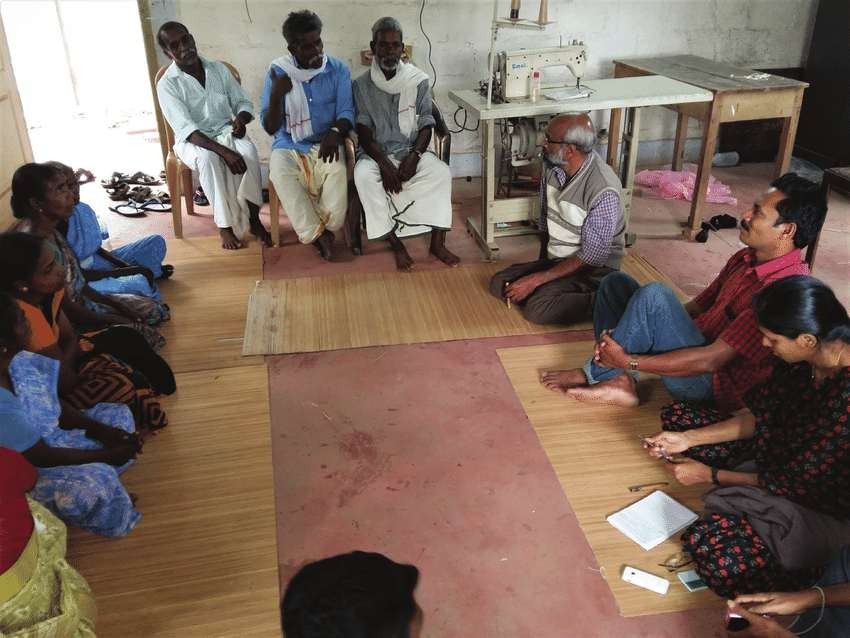

Fig.11 (a) (b): Community Based Flood Management in Kerala state
Sources:The Indian Express
5. Ecosystem Preservation
Decentralization protects natural landscapes—wetlands, lakes, and green zones—that absorb floodwaters and control runoff. Smaller cities can integrate existing natural features into their flood management systems. Example: In Helsinki, Finland, natural spaces are integrated into infrastructure using green corridors and parks to reduce flood risk and enhance livability [9].
6. Infrastructure Modernization
New urban hubs developed through decentralization can be designed from the start with flood-resistant infrastructure, such as:
- Innovative drainage systems
- Permeable pavements
- Green roofs
Example: Songdo International Business District in South Korea employs modern stormwater techniques like rainwater harvesting and green roofs, Fig 12 [8].
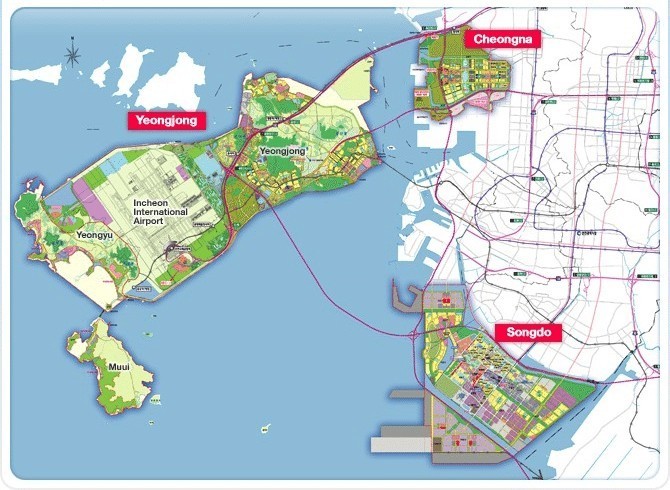 Fig.12: Songdo International Business District Map
Fig.12: Songdo International Business District Map
Sources: www.kgeography.or.kr
7. Reduced population pressure
Decentralization helps redistribute population and economic activities, reducing the stress on major urban centres and their water infrastructure. The population of any city plays a major role in the city’s ability to manage floods. Table 2 includes the population density data along with loss of water bodies due to urbanization of the major densely populated cities of India:

Table 2 Relation between loss of waterbodies with respect to population density
The reduced population pressure lightens the burden on one city's infrastructure by distributing population and economic activities across several areas. This kind of distribution helps to reduce overcrowding, which has often been one of the most important factors behind urban flooding. Decreases in population density within core urban areas can thus reduce the threat of flooding.
Example: Australia has invested in developing cities like Canberra and Geelong to ease pressure on larger hubs like Melbourne and Sydney, Fig 13 [11].
 Fig.13: The Growth of Regional Towns and Cities and Population change in Australia 2001-2011
Fig.13: The Growth of Regional Towns and Cities and Population change in Australia 2001-2011
Sources: Census of Population & Housing, 2015
8. Flexibility and Adaptability
Decentralized urban planning allows flexibility in land use and infrastructure, helping cities to adapt to extreme weather and changing climate conditions. Example: In the Netherlands, decentralization supports adaptive urban development with flexible land use to manage rising sea levels and increased rainfall [7]. Fig 14 illustrates this graphically.
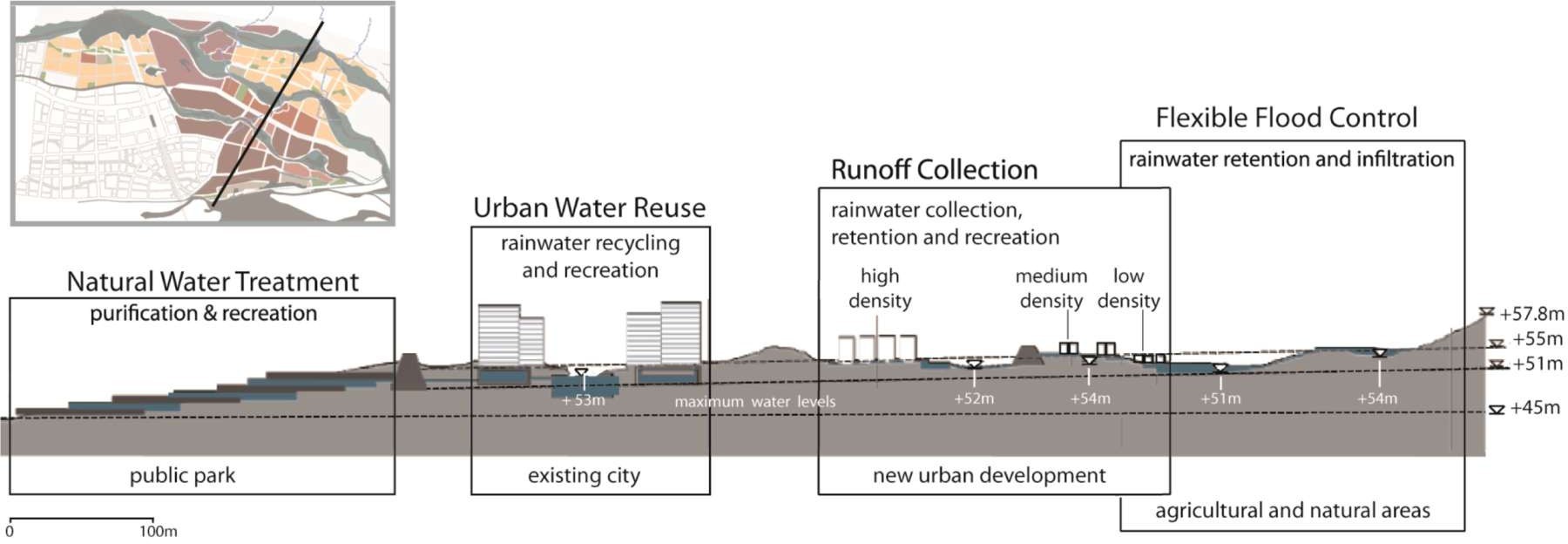 Fig.14: Integrated Decentralized Rainwater Management in Urban Planning and Design in Netherlands
Fig.14: Integrated Decentralized Rainwater Management in Urban Planning and Design in Netherlands
Sources: Integrating Decentralized Rainwater Management in Urban Planning and Design: Flood Resilient and Sustainable Water Management by Thorsten Schuetze
FUTURE COURSE OF ACTION AGAINST URBAN FLOODS IN INDIAN CITIES
The causes of floods in urban India are both natural and human-made. Balanced urban planning that redresses such imbalances between environmental and economic needs is highly essential and is long been overdue. Mitigation and rehabilitation measures need to constitute the central focus area while trying to solve the problem of recurrent floods. Essential strategies include:
New urban hubs developed through decentralization can be designed from the start with flood-resistant infrastructure, such as:
- Maintain records: Maintain record of all water bodies and wetlands at city and village level.
- Protected catchment areas: Declare the catchment areas of rivers, lakes, and other water channels to be protected and include them in the rules for city development.
- Improvement of planning guidelines: Prepare planning guidelines that give more importance to topography, drainage, rainfall, and lithology, and with an improved system of stormwater disposal.
- Urban Water Studies: All these planned and unplanned changes in land use must be studied with and appropriate planning strategies should be evolved for implementation.
CONCLUSION
Flooding in urban India stems from a combination of natural and human-made factors. To address this growing concern, comprehensive urban planning is essential—planning that aligns environmental protection with economic development.
One of the primary concerns is the over-densification of Indian cities. A national policy needs to be introduced that provides strong disincentive for creation of population density beyond sustainable limits, introduces thresholds on economic, environmental, and social indicators, and encourages the development of satellite towns and decentralized urban hubs.
In addition, fostering a culture of disaster risk awareness is vital. Citizens must be educated and engaged in risk reduction practices to strengthen community resilience.
Cities like Chennai, Bengaluru, Kolkata, and Mumbai are increasingly vulnerable to flooding due to: rapid urbanization, climate change, inadequate drainage infrastructure and poor land-use planning
Multi-faceted solutions need to include the following:
1. Infrastructure Upgrades
- Expand and modernize stormwater drainage systems.
- Implement flood-resistant urban designs.
2. Green and Nature-based Solutions
- Promote green roofs, permeable pavements, and urban wetlands.
- Preserve natural water bodies and ecosystems.
3. Decentralization
- Distribute population and economic activity across multiple urban centers.
- Reduce pressure on megacities and improve regional equity.
4. Policy and Regulation
- Enforce strict land-use and zoning laws.
- Mandate environmental impact assessments for all urban development.
With the increasing unpredictability of climate patterns, urban flood management must be proactive and innovative. A combination of policy reform, public engagement, and strategic urban development will be critical to: safeguard lives and property. enhance urban resilience, ensure sustainable and equitable urban growth.
References
-
Intergovernmental Panel on Climate Change (IPCC). Climate Change 2021: The Physical Science Basis. Available at:
https://www.ipcc.ch/report/ar6/wg1/ - Rentschler, J., & Salhab, M. (2022). Flood exposure and poverty in 188 countries. Nature Communications, 13(1). Published June 2022.
- Federal Emergency Management Agency (FEMA). (2023). Designated Areas for Disaster Declarations in 2023. Available at: https://www.fema.gov/disaster/2023/designated-areas
- Raghavan, K. S. (2018). Impact of Climate Change on Urban Flooding in India. International Journal of Environmental Science and Technology, 15.
- Johnston, D. M. (2004). Urban Flooding: Causes, Consequences, and Management.
- Indian Institute for Human Settlements (IIHS). (2015). Understanding Urban Flooding in Chennai and Mumbai: Key Lessons for Urban Resilience.
- Delta Programme Commissioner. (2021). Delta Programme 2021: Continuing to Build a Climate-Resilient Future. Government of the Netherlands.
- Kim, J. (2019). Decentralization and Urban Resilience in South Korea. Urban Studies, 56(5), 949—965.
- European Environment Agency (EEA). (2017). Green Infrastructure and Flood Management in Europe. European Union.
- United Nations & Government of Kerala. (2018). Post-Disaster Needs Assessment: Kerala Floods 2018. United Nations Development Programme (UNDP).
- Australian Government. (2021). State of Australian Cities 2021: National Urban Policy Framework. Department of Infrastructure, Transport, Regional Development, and Communications.
- City of Portland Bureau of Environmental Services. (2019). Portland’s Green Infrastructure: Sustainable Stormwater Management. City of Portland.

